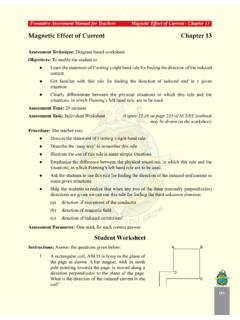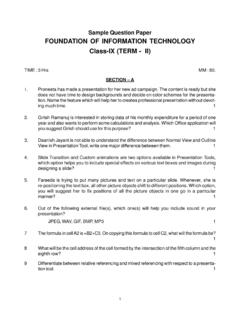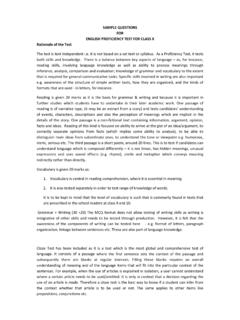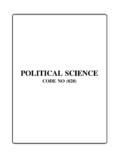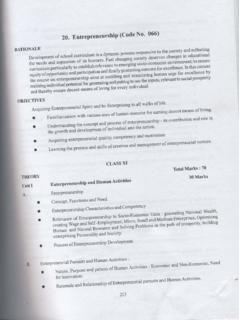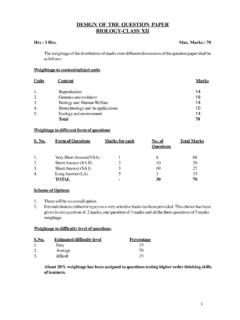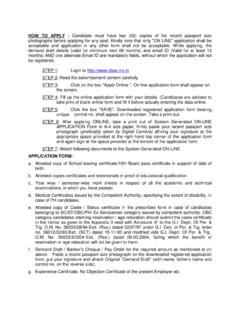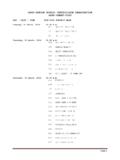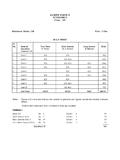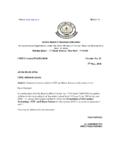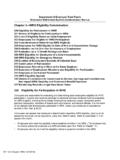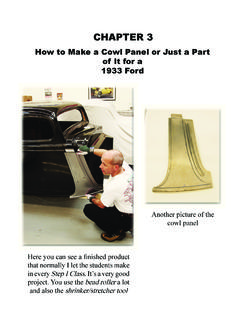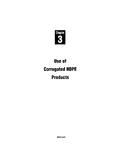Transcription of CCE in Secondary Classes in CBSE
1 CC19 CCE in Secondary Classes in CBSEE mergence of the Concept in CBSEThe FormatEligibilityThe AssessmentThe Central Board of Secondary Education has introduced the scheme of Continuous and Comprehensive Evaluation in its schools in a phased the year 2000, the Board implemented the concept of an independent Certificate of School-based Evaluation to be awarded by the school to all students who passed class X cbse examination. This certificate was awarded in addition to the Board's regular certificate and marks statement related to external examination. It carried a footnote that a certificate of CCE is also being issued by the school and should also be studied for judging the total personality of the student. Besides scholastic areas, co-scholastic areas were included in CCE for assessment over a continuous period of two years Classes IX and X. A recommended format with detailed guidelines was prepared and disseminated to schools for adoption by the cbse .
2 (Annexure 4)As the next step, in 2004, CCE was implemented in primary Classes at I-V (Vide Circulars No. 5/18/25/04). Besides doing away with the concept of pass/ fail system upto class V, the assessment focused on the positive aspects of the child's development during this stage. Accordingly Achievement Records for the primary Classes - (for Classes I & II and Classes III to V) were also developed and recommended to schools with the objective of facilitating holistic learning. As a follow up, the Board decided to extend CCE to Classes VI to VIII in 2006 (Circular No. 2/06). (Annexure 4)The Certificate of School Based Assessment on Continuous Comprehensive Assessment will be available from the cbse and the end of Class X. This will be filled up in the school and sent to the concerned RO in cbse for countersignature. All regular students who have undergone a course of study at the X class of an affiliated school of cbse shall be issued this certificate with effect from the year assessment for Scholastic and Co-Scholastic areas shall be objective and should indicate the performance of the student in a manner as desired below.
3 The assessment will be recorded at the end of Class X in CCE card. This card has been divided into three parts. Now with effort for October 2009, CCE is being implemented in its strengthened form in class IX in all cbse affiliated schools. In the session 2010-11, this will be implemented in both Classes IX and 3 Chapter 3 Continuous and Comprehensive EvaluationCC20As far as Certificate of School Based Evaluation in Classes IX & X is concerned, the parts are given below :consists of the evaluation of Scholastic Attainments which will be reflected both for Classes IX & X in this card in the form of Grades and Percentile Rank. There will be two terms in both Classes IX & X, the first term will be from April - September and the second term from October to March of the subsequent year. Each term will have two Formative and one Summative Assessment. Assessment will be indicated in Grades and Percentile grading Scale for the Scholastic Domain is a nine point grading Scale given at the back of the card.
4 This will assess students for Work-Experience, Art Education and Physical and Health EducationIt will be assessed on a five point grading scaleDescriptive Indicators are statements used to describe each learnerOverall Grade will be given at the end of class IX and class X consists of Co-Scholastic Areas where participants are assessed in two parts; 2(A) Life Skills and Attitudes and Values (2B).Life Skills: This consists of Thinking Skills, Social Skills and Emotional Skills which will be assessed on a five point grading Scale (given at the back of the card).This consists of attitude towards Teachers, Schoolmates, School Programmes and Environment and will be assessed on a three point grading Systems refers to the framework which must be developed right through primary to Secondary level. These will be assessed on a three point grading 1 Part 1 PART 1 (B) PART 2 Part 2 Part 1(A) :Part 2(A) :Part 2(B) :Continuous and Comprehensive EvaluationCC21 PART-3 Part 3 GENERAL consists of Co-Scholastic areas where in choice in participation and assessment thereof is available.
5 This part consists of two sub parts. Literary & Creative skills, Scientific skills, Aesthetic Skills and Performing Art and Clubs (Eco, Health and Wellness clubs etc.). : different kinds of activities have been provided. Indigenous sports (Kho-Kho etc.) / NSS3. Scouting and Guiding4. Swimming5. Gymnastics6. Yoga7. First Aid8. Gardening/ShramdanThe learner needs to be assessed on from the first subpart and from the second Life Skills each of these Co-scholastic areas will be assessed on a three point grading of Scholastic attainments 1(A) will be reported once in class IX and once in class of Scholastic attainments 1(B) will be reported once in class IX and once in class of Co-Scholastic 2(A) and 2(B) will be reported once in class IX and once in class of Co-Scholastic 3(A) and 3(B) will be reported once in class IX and once in class 3(A) : Part 3(B)Eightany two any two Continuous and Comprehensive EvaluationThe nine point grading scale for measuring Scholastic achievements is reproduced below: RangeGradeGrade pointNote.
6 All assessment with regard to the academic status of the students shall be done in marks and overall assessment will be given in Assessment of Performance in the areas like Work Experience, Art Education and Health & Physical Education will to be done on 5-point scale given at the back of the +AB+BCAssessment will be recorded once a BGrade A system of education and examination that teaches members of disadvantaged groups the requisite problem-solving and analytical skills needed by the job market is vital. Memorizing and regurgitating textbooks is not a skill needed by the job market. An exam system that encourages this type of 'learning' snuffs out creativity. To teach skills and create excellence, is the way - perhaps the only sustainable way - toward real equity'.Examination Reform, NCF 2005 - NCERTCC22 Continuous and Comprehensive EvaluationCERTIFICATE OF SCHOOL BASED ASSESSMENT Given is a sample of the Certificate of School Based Assessment which will be used as feed back mechanism for students performance at the end of Class IX and Class and Comprehensive EvaluationCC24 Continuous and Comprehensive EvaluationContinuous and Comprehensive EvaluationCC25 Continuous and Comprehensive EvaluationCC26 Continuous and Comprehensive EvaluationCC27 Continuous and Comprehensive EvaluationContinuous and Comprehensive EvaluationCC28 Continuous and Comprehensive EvaluationHealth StatusHealth education: needs to be assessed on the basis of : Proper development of the body is essential for the healthy growth of the mind.
7 It is therefore, necessary that the students should be examined by qualified doctors twice in a session (July and January). If this facility is not available general information about health height & weight, etc. could be obtained twice in every session. There are already age/sex related charts of height and weight, and teachers should use these charts and note observations on the basis of entries s/he makes on the Report Card / Certificate of addition to this general information, physical disabilities and diseases defective vision, maintenance of teeth, deafness, long absence due to illness, which the teacher can detect at one's own level, should also be noted. S/he should also bring any noticeable handicap to the notice of the parents. In the assessment of Health Status, the recordings of height shall be in centimeters and the weight shall be expressed in the area of Physical Education of the curriculum will be judging the skills / proficiencies acquired by the students in games, sports, PE etc, the area of health education will concentrate on those aspects which constitute the criteria for determining the physical health of an individual.
8 The following aspects will be taken care of in this understanding about healthPhysical fitnessAttitude developmentParticipation in Health and Wellness Club activitiesThe teachers responsibility in this area will be limited to general observations for being communicated to the parents/guardians on the above aspects of health of all students. The suggested format of Health Cards has also been given in the Comprehensive School Health Manual (Volume I). The Health Card records the history in terms of health for all learners from the time of admission to the school till they leave itThe teacher thinks about each individual child and reviews what s/he has learnt during the term and what s/he needs to work on and improve by recording comments and remarks in the Report Card. To be able to write such report cards teachers would need to think about each child individually by observing them during everyday teaching and interaction.
9 One does not need special tests for this, learning activities themselves provide the basis for such ongoing observational and qualitative assessments of children. Maintaining a daily diary based on observation helps in Continuous and Comprehensive Evaluation. CC29 Continuous and Comprehensive EvaluationCC30 Continuous and Comprehensive EvaluationThe suggested format of a Report Card is given below. It is merely suggestive and not mandatory for schools to print a similar Report and Comprehensive EvaluationCC32 Continuous and Comprehensive EvaluationGuidelines For Filling In The CCE CardInside CoverPart - I Academic Performance:Scholastic of Student As required in the CertificateDate of Birth- In words and numbers(Twenty Sixth of November Nineteen Ninety Two 26-11-1992)Mother's NameAs on Birth /Registration CertificateFather's Name ADMISSION 'S REGISTRATION NO.
10 Provided at the time of filling entries. SELF AWARENESSTo be filled at the end of 2years after discussion with the GOALS MY STRENGTHSINTERESTS AND HOBBIES A. Formative Grade = F1 + F2 + F3 + F4=_____ Grade B. Summative Grade = S1 + S2 =_____ GradeOverall Grade -FA-1 (10%) + FA-2 (10%) + FA-3 (10%) + FA-4 (10%) +SA-1 (20%) +SA-2 (40%)Percentile Rank - Calculate using No. of score below x 100 = Percentile Rank n (Total number of students)CC33 Continuous and Comprehensive EvaluationPART 1 (A) : Scholastic AreasPART 2: Co- Scholastic AreasPart (2A) : Life SkillsPART 2(B): Attitude and ValuesPART 3(A) : Co- Curricular AreasPART 3(B): Health and Physical EducationOverall grade of formative Assessments over the two terms (F1+F2+F3+F4) needs to be given and the overall grade of summative Assessment (S1+S2) must be given. A total of the two grades needs to be given in the relevant column.
